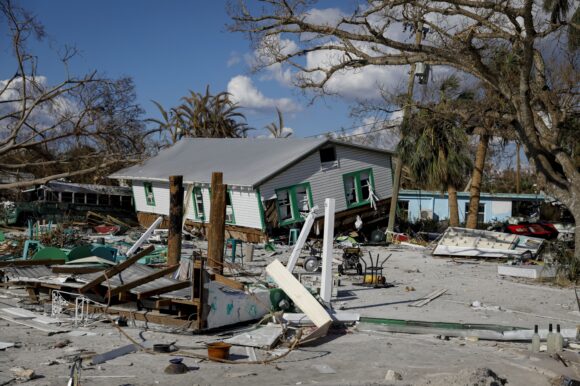When disaster hits in the US, the federal government gives aid to states and counties, but also to individuals. In 2022, the Federal Emergency Management Agency delivered $3.25 billion to nearly 1.4 million households recovering from damaging floods and fires. The aid money helps cover things as large as home repairs and as small as diapers, drinking water, food and other necessities.
This aid regime was created by Congress: The Stafford Act of 1988 threw a lifeline to Americans who were not covered by private insurance, a group assumed to be small. But that can no longer be taken for granted. Insurance rates are rising as costly disasters become more frequent, and with more and more people living in higher-risk areas such as coastal Florida and wildfire-prone parts of the West. Insurance companies are now stepping back from some markets. Just earlier this week, The Hartford announced it would become the latest major insurer to stop writing new policies in California.
“I am starting to see the insurance model breaking down faster,” said Craig Fugate, FEMA’s administrator during the Obama administration. “There are more people that, probably 15 or 20 years ago, had adequate insurance that today are either underinsured, or not even able to afford insurance or get coverage.”
As the need for household assistance has grown, there’s been increasing scrutiny of how the government distributes it. A raft of academic studies have shown that zip codes with fewer White residents get less aid for comparable disasters. And everywhere, people complain about long waits and bureaucratic red tape. Timeliness is of the essence for post-disaster aid. Fast funds to replace, for example, a ripped-off roof can make all the difference to a family, ensuring they’re able to stay put in their community and keep their same jobs and schools, rather than being forced to move away or into government-funded temporary housing, which is also pricey.
A house in Fort Myers Beach, Florida, destroyed by 2022’s Hurricane Ian. Photographer: Eva Marie Uzcategui/Bloomberg
FEMA has been listening. In 2021 it solicited public comments on how to improve its Individual Assistance program. Last week it announced what it called the biggest reforms to the program in two decades, with the intention of streamlining processes and giving out aid more equitably.
Four major changes were:
- A $750 cash benefit for urgent needs will be available automatically in any disaster that qualifies for Individual Assistance. (This replaces a similar benefit that needed to be approved on a disaster-by-disaster basis.)
- Flexible displacement assistance, an upfront cash benefit for displaced people, can be paid to family and friends who are sheltering survivors until a more permanent solution can be found.
- Survivors can seek grants from FEMA without having to first apply for a home repair loan from the US Small Business Administration.
- A new home repair allowance of $42,500 will be available for people who have private insurance, for costs exceeding the insurance payout.
When current FEMA Administrator Deanne Criswell announced the reforms, she acknowledged ever-greater demand because of climate-fueled catastrophes. There’s been a sharp increase in US disasters that cause upwards of $1 billion in damages. The average annual number of such events over the past four decades (from 1980 to 2023) was 8.5, but in 2023 alone there were 28, according to the National Oceanic and Atmospheric Administration.
“We are breaking records year after year with these disasters, and we need to be better prepared and informed to recover faster and more effectively,” Criswell said in a call to reporters.
It’s not in FEMA’s purview to do anything about private insurance. But if the underlying problem — an underinsured populace — remains unsolved, it can only lead to more taxpayer subsidies. FEMA estimates the new reforms will add at at least another half billion dollars a year to the federal tab.
Fugate doubts the country will fix this feedback loop anytime soon. “We’ve been underpricing risk in this nation so long, we’ve built this dynamic now where people have built and live in areas that are increasingly vulnerable to these disasters,” he said. “The insurance industry can’t make it work, so the taxpayer will pay more and more.”
Top photo: A house in Fort Myers Beach, Florida, destroyed by 2022’s Hurricane Ian. Photographer: Eva Marie Uzcategui/Bloomberg
Was this article valuable?
Here are more articles you may enjoy.


 What The Return of California’s ‘Death Discount’ Means for Litigation
What The Return of California’s ‘Death Discount’ Means for Litigation  Allianz Built An AI Agent to Train Claims Professionals in Virtual Reality
Allianz Built An AI Agent to Train Claims Professionals in Virtual Reality  Billionaire NFL Owner Suing Over Billboards Near His SoFi Stadium
Billionaire NFL Owner Suing Over Billboards Near His SoFi Stadium  Storm Goretti Batters Europe With Violent Winds, Power Cuts
Storm Goretti Batters Europe With Violent Winds, Power Cuts 